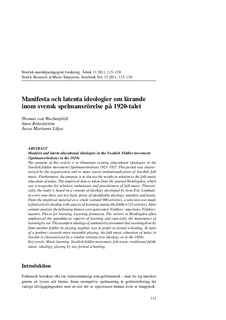Manifesta och latenta ideologier om lärande inom svensk spelmansrörelse på 1920-talet
Chapter, Peer reviewed
Permanent lenke
http://hdl.handle.net/11250/172349Utgivelsesdato
2012Metadata
Vis full innførselSamlinger
- Artikler og bokkapitler [390]
Originalversjon
I: Nordic Research in Music Education. Yearbook Vol. 13 2011, s. 115-130Sammendrag
The purpose of this article is to illuminate existing educational idologies in the Swedish fiddler movement (Spelmansrörelsen) 1923-1927. This period was characterized by the organization and to some extent institutionalization of Swedish folk music. Furthermore, the purpose is to dicuss the results in relation to the folk music education of today. The empirical data is taken from the journal Hembygden, which was a magazine for scholars, enthusiasts and practitioners of folk music. Theoretically, the study is based on a concept of ideology deveoped by Sven-Eric Liedman: in every time there are two basic forms of identifiable ideology, manifest and latent. From the empirical material as a whole (around 900 articles), a selection was made to find articles dealing with aspects fo learning among the fiddlers (33 articles). After content analysis the following themes were generated: Fiddlers' repertoire, Fiddlers' masters, Places for learning, Learning formation. The writers in Hembygden often emphasized the autodidactic aspects of learning and especially the importance of learning by ear. This manifest ideology of authenticity presumed that learning directly from another fiddler by playing together was to prefer to formal schooling. In spite of a tendency towards more ensemble playing, the folk music education of today in Sweden is characterized by a similar retrospective ideology as in the 1920s. Key words: Music learning, Swedish fiddler movement, folk music, traditional fiddle music, ideology, playing by ear, formal schooling.
Utgiver
Norges musikkhøgskoleSerie
NMH-publikasjoner;2012:2Nordisk musikkpedagogisk forskning;Årbok 13
